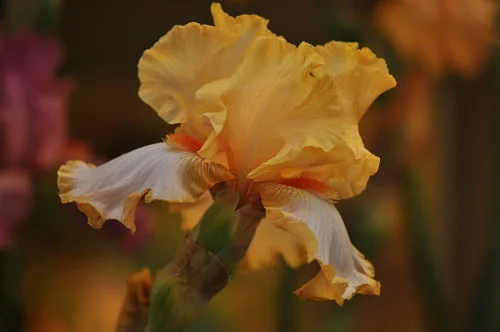Time to divide your irises
/German or “bearded” irises need regular dividing. — PMilera4/Creative Commons
The hot and steamy height of summer is just about the worst time to think of planting or transplanting much of anything, but there is, as usual, an exception to the rule.
Mid-July through mid-September is prime time for digging, dividing and planting German, or "bearded," irises, a favorite May-blooming perennial. Irises need warm soil to set new roots, so trying to transplant them in the spring or fall often leads to failure. Now is the time.
On the whole, irises are long-lived and trouble-free, but they do spread and multiply rather quickly. If you can't remember when you last divided your clump, it has probably been too long.
Congested irises can create a rhizome traffic jam and the crowded conditions often mean that your flower count drops dramatically.Irises are usually at their best and most prolific in the two or three years following division.
I think of irises as the most sociable of plants, since you only need some to have lots. This means there are usually plenty to share with friends, and by now, my irises have traveled far and wide. I've probably given away in excess of 100 rhizomes by now — and there are always more to distribute.
Digging and processing a clump or two of irises in the early morning or the cool of the evening is no big chore, especially since you needn't replant them immediately. These drought-resistant plants can remain out of the ground a few days without harm, a trait that makes them more portable than most plants.
The digging part I do with a garden fork, being careful not to impale the thick, tuberous rhizomes. Irises don't grow deep into the ground, but rather spread at the surface, so all you need to do is pry them up. The processing part takes place on my patio. I drag the plants there in a small cart so I can work from a comfortable seat with a cold drink nearby.
The mass of rhizomes sometimes can be picked apart, but more often, you need to cut them in sections with a knife or pruning shears. You want at least one fan of leaves on each piece, but larger divisions can have two or three. Pare away any part of a rhizome that looks soft or funky.
The sword-like leaves attached to the rhizomes can be 2 feet to 3 feet tall at this point in the season. Leaving them full-sized will make the transplant too top heavy, so take your pruners and cut them back to 6 inches or 8 inches.
A properly planted iris rhizome. — Science and Plants for Schools/CC
This work goes quickly once you get into the rhythm, and you'll wind up with a bag of nicely cleaned rhizomes that you can store (in a paper bag left in a cool, shaded spot) until you are ready to plant. When replanting, choose a spot in full sun with well-drained soil — a damp location will lead to root rot.
Irises prefer a lean, coarse soil and one that is close to neutral on the pH scale, the measure of how acid or alkaline your soil is.
These plants do well in the sandy soils common in the southern half of the state, although such soils (supporting acid-lovers like oak, pine and azaleas) may need to be amended with a handful of lime. Where claylike soils prevail, mixing vermiculite into the soil may promote better drainage; planting irises in raised beds or at the top of a slope also helps.
Figure on planting a group of three to five rhizomes 12 to 14 inches apart with the fan of leaves, representing the direction of new growth, pointing outward. Excavate a shallow depression, perhaps 3 inches to 5 inches deep, in a rough oval.
You want to bury the hairlike roots, but leave the top of the thick rhizome exposed at the surface of the soil. Elevate each rhizome by settling it on a little mound of soil before you scoop soil over the roots. Water for a week or so, until new growth appears. Once established, irises rarely need watering, even in dry spells.
Irises dislike high-nitrogen fertilizers, so don't think you're doing them a favor by dosing them with Miracle-Gro or amending their planting hole with manure. You can fertilize lightly with a product that has a 10-30-20 formula in the spring when leaf fans are about 6 inches tall and temperatures have warmed to at least 50 degrees. In decent soil, irises may need no supplemental feeding at all.
After flowers bloom, you can neaten up by cutting the flower stalks to the base, which prevents the plant from forming useless seed pods. Since most irises are hybrids, they won't duplicate themselves from seed — division is the way to propagate them, and each piece of the whole will be identical to the parent plant.
The best thing you can do for your irises is to clean up the dead foliage at the end of the season. The plant's only serious pest is the iris borer, which overwinters in the spent foliage and attacks leaves and rhizomes when spring arrives and growth resumes.


